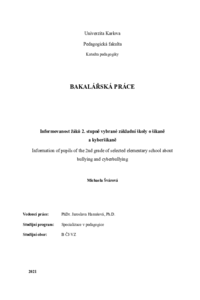Informovanost žáků 2. stupně vybrané základní školy o šikaně a kyberšikaně
Information of pupils of the 2nd grade of selected elementary school about bullying and cyberbullying
bakalářská práce (OBHÁJENO)

Zobrazit/
Trvalý odkaz
http://hdl.handle.net/20.500.11956/147939Identifikátory
SIS: 221004
Kolekce
- Kvalifikační práce [18094]
Autor
Vedoucí práce
Oponent práce
Syřiště, Ivo
Fakulta / součást
Pedagogická fakulta
Obor
Český jazyk se zaměřením na vzdělávání - Výchova ke zdraví se zaměřením na vzdělávání
Katedra / ústav / klinika
Katedra pedagogiky
Datum obhajoby
8. 9. 2021
Nakladatel
Univerzita Karlova, Pedagogická fakultaJazyk
Čeština
Známka
Výborně
Klíčová slova (česky)
agresor, šikana, oběť, kyberšikanaKlíčová slova (anglicky)
aggressor, bullying, victim, cyberbullyingPráce se zabývá šikanou a kyberšikanou. Ukazuje její formy a druhy, koho všeho se může šikana týkat a přímé aktéry. Popsána je zde i prevence a organizace, které se jí zabývají a mohou tak dětem s problémem pomoci. Nastíněná jsou zde i legislativní opatření v případě závažného problému. V praktické části jsou dotazovaní žáci 2. stupně ZŠ, kteří odpovídali na to, jaká je jejich zkušenost se šikanou a kyberšikanou, jak vše řešili a na koho se v případě problému obrátili. Praktickou část ještě doplňuje rozhovor s metodičkou prevence na škole, kde byl žáků podáván dotazník. Vyhodnocení dotazníku ukázalo, že se žáci se šikanou i kyberšikanou setkali. Jako oběť šikany se ukázalo 28% dotazovaných, kyberšikany 5%. Také se zjistilo, že v případě problému by se šli nejčastěji svěřit rodičům, uvedlo to 46% dotazovaných, protože v nich mají důvěru. KLÍČOVÁ SLOVA agresor, kyberšikana, oběť, šikana
The work deals with bullying and cyberbullying. It shows its forms and types, who can be affected by bullying and direct actors. It also describes prevention and organizations that deal with it and can help children with a problem. Legislative measures in the event of a serious problem are also outlined here. In the practical part, the pupils of the 2nd grade of primary school are interviewed, who answered what is their experience with bullying and cyberbullying, how they solved everything and to whom they turned in case of a problem. The practical part is supplemented by an interview with the prevention methodologist at the school where the pupils were given a questionnaire. The evaluation of the questionnaire showed that the pupils encountered both bullying and cyberbullying. 28% of respondents turned out to be victims of bullying, 5% to cyberbullying. It was also found that in the event of a problem, they would most often confide in their parents, 46% of respondents said because they trust them. KEYWORDS aggressor, cyberbullying, victim, bullying
